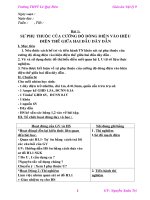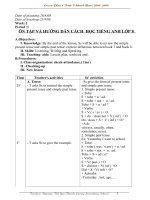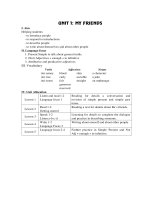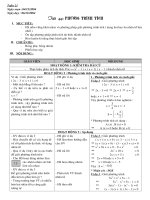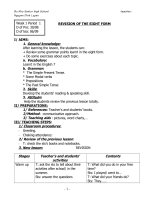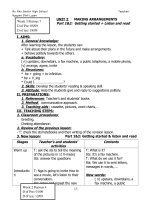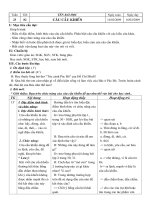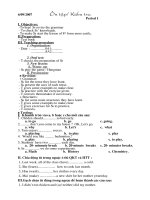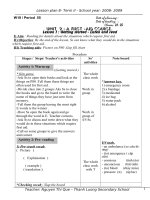giao an anh 8 2 cot
Bạn đang xem bản rút gọn của tài liệu. Xem và tải ngay bản đầy đủ của tài liệu tại đây (435.41 KB, 113 trang )
Week: 1 Date of teaching: 21/8
Period: 1 Class: 8A
Written test
Time 45 minutes
A. Questions
I. Choose the best answer:
1. Would you like………….table tennis, Nam? - Yes, I’d love to.
A. play B. playing C. to play D. plays
2. Lan………..to school everyday.
A. go B. going C. to go D. goes
3. I don’t really like…….computer games.
A. to play B. playing C. play D. plays
4. I like bananas………….
A. So do I B. So I do C. I do, so D. Do am I
5. ………you …….free tomorrow?
A. Do /do B. Are /be C. Were/be D. Will/be
6. What about…………to the movies?
A. to go B. go C. going D. we go
7. My mom……….me a new bike last summer.
A. buys B. bought C. buy D. to buy
8. Lan is a slow swimmer. She swims………
A. slow B. more slowly C. slowly D.slowlier
9. I often go to Hanoi ……the summer.
A. on B. at C. to D. in
10. We are interested…….English.
A. in B. of C. at D. on
II. Read the passage and answer the questions:
Hoa is a student at Quang Trung School. She goes to school six days a
week. She is good at Math and English and she likes studying Computer Science,
too.
Last month, she had a really wonderful vacation in Nha Trang. She went
there with her parents. Her uncle and aunt live there. She did a lot of things: she
went swimming a lot in the morning with her sister, visited some islands by boat
and went to Pearl Island to see Miss Viet Nam contest. She came home last week
and she is preparing for the new school year now.
1. Which school does Hoa go to?
……………………………………………………………………?
2. What subjects is she good at?
……………………………………………………………………?
3. Did she have a wonderful vacation last month?
1
……………………………………………………………………?
4. Did she go swimming in the afternoon?
……………………………………………………………………?
5. What did she do in the Pearl Island?
……………………………………………………………………?
6. What is she doing now?
……………………………………………………………………?
III. Complete the sentences, using the words given:
1.They/play/ soccer/with/some/friends/at/moment.
……………………………………………………………………
2.How far/ be/ it/ your house/ the movie theater?
……………………………………………………………………
3. Mr. Tuan/work/few/hours/Mr. John.
……………………………………………………………………
4. Yesterday/I/buy/new shoes.
…………………………………………………………………..
IV. Listen and fill in the missing words:
I sometimes go to the (1).………… with my friends on Sunday but last Sunday I
didn’t. I visited my (2)……….. in Ha Noi. I went there by (3)…………… It is
about……………..(4) from my house. My uncle and aunt were there, too. We
went to the market and bought some …………..(5). My aunt cooked very (6)
…………..and we had a delicious meal. We talked until (7)………..in the
evening. I came home at (8)………….
1………..2………….3…………..4…………..
5………..6………….7…………..8………….
B. Answers and remarks:
I. 3 points (each correct answer gets 0.3 points)
1C, 2D, 3B, 4A, 5D, 6C, 7B, 8C, 9D, 10A
II. 3 points (each correct answer gets 0.25 points)
1. Hoa goes to Quang Trung School. 4. No, she didn’t
2. She is good at Math and English. 5. She saw Miss Viet Nam Contest
3. Yes, she did. 6. She is preparing for the new school year.
III. 2 points (each correct answer gets 0.25 points)
1. They are playing soccer with some friends at the moment.
2. How far is it form your house to the movie theater?
3. Mr. Tuan works few hours than Mr. John.
4. Yesterday I bought new shoes..
IV. 2 points (each correct answer gets 0.25 points)
1. movies 2. grandparents 3. bus 4.100km
5. seafood 6. well 7. 7 8. 9 pm
2
Week : 1 Date of teaching:26/8
Period : 2 Class: 8A,C
Unit 1: My friends
Lesson 1: Getting started + Listen and read (Page 10 -11)
A. Objectives:
By the end of the lesson, students will be able to:
- Understand the dialogue between Hoa and Lan about Nien, one of Hoa’s
friends in Hue.
- Know how to use the structure : adj + enough + to infinitive.
B. Teaching aids:
- Poster,pictures ( Text book page 10 )
C. Ways of working:
- Individual.
- Pairs, groups.
D. Procedure:
I. Warm up:
* Getting started:
- Teacher (T) asks students (Ss) to look at the pictures (page 10 ) and answer the
questions:
What do they do in picture a ?
- T asks the same questions for the rest pictures.
- Ss answer individually.
- T asks some questions about Ss’ activities.
1. What did you do during your summer vacations?
2. Did you read a lot of books?
3. Did you play volley ball ?
- Some Ss answer individually.
II. New lesson:
Teacher and students activities’ Contents
1. Pre - reading:
* Pre - teach vocabulary:
- T elicits words form Ss
(translation)
(example)
( translation)
( situation)
- Ss read the words chorally/ individually.
Checking vocabulary technique: R & R
*Pre - questions:
- T gives the picture of Hoa and Lan and elicits
the situation.
- T asks Ss to guess the answer for the questions
- seem (v): dêng nh, cã vÎ nh
- next - door neighbor (n) : hµng
xãm c¹nh nhµ
- look like (v) : tr«ng nh thÕ nµo
- enough (adv): ®ñ
1. Is Nien Lan’s friend or Hoa?
2. How old is Nien?
3. Where does she live?
3
- Ss guess and give their ideas individually with
their books closed.
2. While - reading:
- T asks Ss to listen to the dialogue and check
their predictions.
- Ss listen first and then read the dialogue in pairs
to check their prediction.
- T gives the answer keys for the questions
* Comprehension questions: Lucky numbers
- T gives questions on a poster and asks the class
to play in two teams
- Ss choose the lucky numbers form 6 numbers
given and play in two teams.
- T asks Ss to ask and answer the questions in
closed pairs.
- Ss ask and answer in closed pairs.
* Model sentences:
- T elicits the model sentence by asking the
question:
Which sentence tells you that Hoa is older than
Nien?
- A S answer.
- T gives the model sentence and asks Ss to repeat
it.
- Ss repeat chorally and individually.
* Concept check:
- Meaning: What does this sentence mean in
Vietnamese?
- Use:
- Pronunciation: Ss put the stress.
* Practice: Word - cue drill:
- T gives some cues and asks Ss to run through.
- Tasks Ss to make full sentences, using the cues.
- Ss do chorally and then individually.
- T asks Ss to write full sentences.
- Ss write in two teams on the board.
1. Nien is Hoa’s friend.
2. Nien is 12 years old.
3. She lives in Hue.
1.
2. Where does Nien live?
3. Does Lan know Nien?
4.
5. Which sentence tells you that
Hoa is older than Nien?
6. When is Nien going to visit
Hoa ?
She wasn t old enough to be in’
my class.
1. We/not/old/ride/a/ car.
2. He/intelligent/do the exercise.
3. I/not strong/lift/ box.
4. They/ tall/play/volley ball.
III. Homework:
- Learn by heart the vocabulary, make sentences with the new words.
- Make 5 sentences, using the structure you’ve learnt.
- Translate the dialogue.
- Be ready for “Speak” (Find the new words and words related to describing
appearance)
TuÇn: 1 Ngµy d¹y: 27/8
4
Be + adjective + enough + to V
AB
TiÕt: 3 Líp 8A
Unit 1: My friends
Lesson 2: Speak ( Page 11 -12)
A. Objectives:
By the end of the lesson, Ss will be able to:
- know how to describe the appearance of people, using the adjectives they have
learnt.
B. Teaching aids:
- Posters.
- Pictures (page 11, 12 text book)
C. Ways of working:
- Individual, pairs, groups.
D. Procedure:
I. Warm up:
- Chatting about weather and health.
* Hang man:
- T asks Ss to guess the letters of the words about appearance.
- Ss guess individually each letter.
– – – – – (short)
– – – – (long)
– – – – (thin)
– – – – – (black)
II. New lesson:
Teacher and students acvtivities’ Contents
1. Presentation:
* Pre - teach vocabulary:
- T elicits words from Ss
( picture)
(picture)
(picture)
(picture)
- Ss read the vocabulary chorally/ individually.
Checking vocabulary technique: What and
where.
* Presentation dialogue:
- T elicits the dialogue from Ss (page 11 textbook):
Hoa and Lan are playing guessing game. Hoa
describes one person and Lan guess who is she/he.
- Ss repeat the dialogue chorally and in open pairs.
- slim (adj) : m¶nh mai
- curly (adj): xo¨n, qu¨n
- bald (adj): hãi
- straight (adj): th¼ng
Hoa: This person is short and
thin. She has long blond hair.
Lan: Is this Mary?
Hoa: Yes.
5
slim
curly
bold
straight
* Concept check:
- Meaning: Two Ss translate the dialogue into
Vietnamese.
- Form: - T gives the way to ask about appearance.
- Use: Asking and answering about appearance.
- Pronunciation: Ss put the stress.
2. Practice:
* Word - cue drill:
- T gives some cues and asks WC to run through.
- T gets Ss to make full sentences, using the cues.
- Ss work in open then closed pairs.
- T calls some pairs of Ss to check.
* T asks Ss to make similar dialogues, using the
adjectives in the table.
- T asks some open pairs to demonstrate first.
- Some open pairs perform.
- T asks Ss to work in open pairs, making some
dialogue, guessing about the people in the pictures.
- Ss work in closed pairs.
- T calls some pairs to check.
3. Production:
* Guessing game:
- T asks Ss to work in pairs again to play the
guessing game. One S has to describe one of their
classmate, another S has to guess who is he/she.
- Some open pairs play first and WC play in closed
pairs.
- Tasks some Ss to play before the class.
1. He/short/ short black hair.
2. Lan/ tall/fat/ long brown
hair.
3. She/ slim/ long straight
hair.
4. Hung/tall/fat/ short dark
hair.
* Example exchange:
A: What does he look like?
B: He is short and he has
short black hair.
* Example exchange:
S1: This person is short and
fat. He is bold.
S2: Is that Mr. Lai?
S1: Yes, that’s right.
III. Homework:
- Learn by heart the new words, make sentences with the new words.
- Make 2 dialogues, using the adjectives.
- Be ready for next lesson: Unit 1: Listen (page 12,13, find new words)
TuÇn: 2 Ngµy d¹y:28/8
TiÕt: 4 Líp : 8A
Unit 1: My friends
6
What + do/does + S +
look like?
Lesson 3: Listen + Language Focus 4 ( Page 12, 13, 17)
A. Objectives:
By the end of the lesson, Ss will be able to:
- know how to open and end a conversation.
- revise the structure: adjective + enough + to infinitive.
B. Teaching aids:
- Posters.
- T’s and Ss’ books.
C. Ways of working:
- Individual, pairs, groups.
D. Procedure:
I. Warm up:
- Chatting about health and weather.
* Jumble words:
- T gets Ss to find the words or phrases from the disordered letters.
- Some Ss write on the board.
1. cssalaetm (classmate)
2. cein (nice)
3. pealures (pleasure)
4. ceom (come)
5. od how od uoy ( how do you do)
- T gets Ss to read chorally/ individually.
- Some Ss read.
II. New lesson:
Teacher and students activities’ Contents
1. Pre - listening:
* Matching:
- T asks Ss to match the words or phrases to the
Vietnamese meanings:
- T gets some Ss to match on the board.
- Ss match and repeat chorally/ individually.
- T sets the scene: You are going to listen to the
dialogues having these phrases.
2. While - listening:
- T asks some Ss to read the dialogues.
- Some Ss read the dialogues aloud ( in open
pairs)
- T asks Ss to listen to the dialogues (page 12
and 13 ) and complete the conversations with
the expressions given.
- Ss listen and fill in the missing information.
- T gets Ss to listen twice.
1. How do you do?
2. Good bye. See you later.
3. I must go now, good bye.
4. Nice to meet you.
5. I’d like you to meet Mr.
Thanh.
6. It’s a pleasure to meet you.
A. T«i ph¶i ®i ®©y, chµo nhÐ.
B. Xin chµo
C. T«i muèn b¹n g¨p «ng
Thanh.
D. RÊt h©n h¹nh khi gÆp b¹n.
E. RÊt vui khi gÆp b¹n.
F. Chµo, hÑn gÆp l¹i b¹n sau.
* Answer keys:
(1), (3) I’d like you to meet.
(2) Nice to meet you.
7
- Some Ss read aloud the phrases they have
listened.
3. Post - listening:
* Language Focus 4 (page 17)
- T asks a S to write the form and another tell
the meaning and use.
- Ss write on the board.
- T focuses again on the use and the position of
“enough”
* Exercise 4 (page 17)
- T gets Ss to do the exercise in groups.
- Ss discuss in groups and write the answers on
the scrap papers.
- T asks some Ss to read full sentences.
- Some Ss read aloud the full sentences.
- T and WC check.
(4) It’s a pleasure to meet you.
(5) Come and meet….
- T asks Ss to read the dialogues
in pairs (open then closed pairs)
- Ss read the dialogues in open/
closed pairs.
* Answer keys:
b. Ba is not old enough
c. I am strong enough
d. good enough
- T gets Ss to read aloud the
dialogues.
- Ss read in closed pairs.
III. Homework:
- Learn by heart the phrases and make sentences with them.
- Do exercises 1, 2 (Workbook)
- Make 3 sentences with the structure : adj + enough + to infinitive.
- Be ready for the next lesson: Unit 1 Lesson 4: Read (page 13, 14)
( Find new words and phrases, foresee the text about Bao, Khai, Song)
Feedback:
……………………………………………………………………………………
………………………………………………………………………….
…………………………………………………………………………………….
…………………………………………………………………………………….
…………………………………………………………………………………….
…………………………………………………………………………………….
……………………………………………………………………………………
TuÇn: 2 Ngµy d¹y:9.9
TiÕt: 5 Líp : 8A
Unit 1: My friends
8
(not) adjective + enough
+ to infinitive
Lesson 4: Read (page 13- 14)
A. Objectives:
By the end of the lesson, Ss will be able to:
- understand the text about Ba’s friends and know more words of characters
- do some exercises related.
B. Teaching aids:
- Posters, picture (page13)
- T’s and Ss’ books.
C. Ways of working:
- Individual, pairs, groups.
D. Procedure:
I. Warm up:
- Tasks Ss to answer some questions.
- Ss answer individually. They can answer in Vietnamese.
1. Have you got any close friends in our class?
2. What does he/ she look like?
3. What is he/ she like?
4. Do you and your friend have the same feelings?
II. New lesson:
Teacher and students activities’ Contents
1. Pre - reading:
* Pre - teach vocabulary:
- T elicits words from Ss, using different
techniques
(example)
(example)
(situation)
(example)
(example)
(situation)
(example)
- T gets Ss to read the words chorally and
individually.
- Ss read chorally, some Ss read individually.
Checking vocabulary technique: Matching
- T asks Ss to match English words and
Vietnamese meanings.
- Ss match individually on the board.
* T - F Statements:
- T asks Ss to predict if the statements are T or F
- Ss predict individually with closed books.
character (n) : tÝnh nÕt, tÝnh
c¸ch.
orphanage (n) : tr¹i må c«i
sociable (adj) : dÔ hoµ ®ång
generous (adj) : hµo phãng,
réng lîng
volunteer (adj/n ) : t×nh
nguyÖn, t×nh nguyÖnviªn
reserved (adj) : kÝn ®¸o, dÌ
dÆt.
joke (n) : lêi nãi ®ïa
1. Ba only has 3 friends: Bao,
Song, Khai.
9
2. While - reading:
- T asks Ss to open their books, read the text and
check their predictions.
- Ss read silently and check predictions.
- T gets Ss to correct false statements.
- Ss correct false statements.
* Multiple choice:
- T asks Ss to read the text again and choose the
best answer.
- Ss work in pairs to do the exercise.
- T, WC correct.
* Comprehension questions:
- T gets Ss to work in pairs to answer the
questions.
- Ss work in closed pairs.
* Lucky numbers:
- T gets Ss to play in two teams
3. Post - reading:
- T asks Ss to find the characters of Ba’s friends.
- T asks S to write in small groups
- Ss do in group of 4.
- T, WC correct.
- T asks Ss to write about their characters.
- Ss write individually.
2. Ba and his friends have the
same charaters.
3. Bao, Song, Khai are quite
reserved in public.
4. They all enjoy school and
study hard.
* Answer keys:
1. F (Ba has many friends )
2. F ( the same different)
3. F ( Khai and Song, not Bao
Khai and Song)
4. T
* Answer key:
a. A c. B
b. C d. D
1. Question b. 5. Question a.
2. 6. Question c
3. Question d 7. Question f
4. Question e 8.
* Answer keys:
a. He feels lucky to have a lot
of friends.
b. Bao is the most sociable.
c. Khai likes reading.
d. His jokes sometimes annoy
his friends.
e. Bao spends his free time at a
local orphanage.
f. Ss’ answer.
III. Homework:
- Learn by heart vocabulary, make sentences with them
- Do exercise 2, 3 workbook.
- Be ready for next lesson: Unit 1: Write ( page 17).
TuÇn 2 Ngµy d¹y:9.9
TiÕt 6 Líp : 8A
10
Unit 1: My friends
Lesson 5: Write (page 15)
A. Objectives:
By the end of the lesson, Ss will be able to:
- write about their friends ( appearance and characters)
- know more words about appearance and characters
B. Teaching aids:
- Posters
- T’s and Ss’ books.
C. Ways of working:
- Individual, pairs, groups.
D. Procedure:
I. Warm up:
- Chatting about Ss’ friends:
- T asks : 1. Do you have any closed friends in our class?
2. What does he/ she look like?
3. What is he/ she like?
4. Where does he/ she live?
5. What do you often do together?
- Some Ss answer individually.
II. New lesson:
Teacher and students activities’ Contents
1. Pre - writing:
* Reading for information:
- Tasks Ss to read the information about
Tam (page 15)
- A S reads, WC listen.
- T asks Ss some questions to check Ss’
understanding
- Ss answer individually.
- T shows the paragraph about Tam and
asks a S to read aloud.
2. While - writing:
- T asks Ss to fill in the form, writing
information about one of their friends.
- Ss fill in the form individually, using
the questions ( page 15) as prompts.
- T asks Ss to ask their partners
information about their friends.
- Ss ask and answer in closed pairs.
- T gets some pairs to perform.
* Writing:
1. What is his name?
2. How old is he?
3. What does he look like?
4. What is he like?
5. Who are his friends?
Name:
Age:
Appearance:
Characters:
Address:
Family:
Friends:
* Questions:
a. What is his/ her name?
b. How old is he/ she?
c. What does he/she look like?
d. What is he/ she like?
11
- T asks Ss to write a paragraph about
one of their friends, using the
information they have written.
- Ss write individually.
- T goes round and helps Ss.
3. Post - writing:
* Correction:
- T collects some Ss’ writing, asks them
to read aloud their paragraph and gets
WC to check for errors.
- Some Ss read their writing, WC check
and correct mistakes if necessary
e. Where does he/ she live?
f. Who does he/ she live with?
g. Who is/ are his/ her friends?
* Sample paragraph:
My friend’s name is Hoa and she
is 14 years old. She lives in Hoa Binh
with her parents and her sister, Lan. She
is tall and thin and has long black hair.
She is helpful and sociable. Her best
friends are Hung and Hue.
III. Homework:
- Write a paragraph about another friend.
- Do exercise 5 (Work book)
- Be ready for next lesson: Unit 1: Language Focus 1, 2, 3 ( page 17)
* Feed back: ……………………………………………………………………..
……………………………………………………………………………………
……………………………………………………………………………………
……………………………………………………………………………………
………………………………………………………………………………….....
....................................................................................................................
....................................................................................................................
TuÇn: 3 Ngµy d¹y:10.9
TiÕt : 7 Líp : 8A
Unit 1: My friends
12
Lesson 6: Language Focus 1,2,3 (page 16, 17)
A. Objectives:
By the end of the lesson, Ss will be able to:
- revise the form and use of the past simple tense and the present simple tense to
talk about general truths.
- do some exercise related
B. Teaching aids:
- Posters, word cues
- T’s and Ss’ books.
C. Ways of working:
- Individual, pairs, groups.
D. Procedure:
I. Warm up:
- Chatting about health and weather.
* Give the correct form of the verbs, using the present simple tense or the
past simple:
1. My name (be) Hoa. I (go) to Quang Trung School. Every day I (get) up early
and (get) to school by bus. But yesterday I (go) to school by bike.
2. Last summer we (have) a vacation in Nha Trang.
3. Hoang (receive) a letter from Hoa yesterday.
4. She (visit) her grandparents every summer.
- Some Ss do on the board, T and WC correct.
* Answer key:
1. is/ go/ get/ get/ went 2. had
3. received 4. visits
II. New lesson:
Teacher and students activities’ Contents
1. Presentation:
* Pre - teach vocabulary:
- T elicits words from Ss
(example)
(picture)
(picture)
(example)
- Ss read the vocabulary chorally/ individually.
Checking vocabulary technique: Rub out
and Remember.
* Model sentence:
- T elicits: Where does the sun rise?
- T gets Ss to read chorally/ individually.
- Ss read model sentence chorally/ individually.
* Concept check:
- Meaning: A S translates the model sentence into
- planet (n): hµnh tinh
- Mars (n): sao Ho¶
- Mercury (n): sao Thuû
- silly(n): ngèc nghÕch
The Sun rises in the East
13
Vietnamese.
- Form:
- Use: What tense do we use in the sentence?
The present simple: to talk about general
truth.
- Pronunciation:
2. Practice:
- T asks Ss to do the exercise 2 ( page 16) in
small groups
- Ss work in groups of 4 to do the exercise.
- T and WC correct.
* Exercise 1(page 16)
- T gets Ss to do the exercise in pairs, T focuses
on the use of the present and past simple tense.
- Ss do in pairs.
- T asks some Ss to write the correct answer on
the board.
- Some Ss write the answer on the board.
- T and WC correct.
3. Production:
* Language Focus 3:
- T and WC run through the questions.
- T gets Ss to work in pairs, ask and answer about
people in the picture.
- Ss work in open pairs then in closed pairs.
* Answer key:
1. sets 4. is
2. moves 5. is
3. moves 6. is
* Answer key:
a. 1. lives 2. sent
3. was 4. is
b. 1. are 2. came
3. showed
4. introduced
* Example exchange:
A: What is the man look like?
B: He is tall and fat. He has
short dark hair.
A: What is he wearing?
B: He is wearing yellow shirt
and brown trousers.
- T asks some pairs of Ss to
demonstrate.
- Some pairs perform.
III. Homework:
- Learn by heart the vocabulary and make sentences with the new words.
- Do exercise 6 (Workbook)
- Copy the answers of exercise 1, 2, 3, 4 (Language Focus) to your notebook.
- Be ready for the next lesson: Unit 2: Making arrangement
Lesson 1: Getting started - Listen and read
( Find new words and names of the objects)
TuÇn 3 Ngµy d¹y:
TiÕt 8 Líp : 8A
Unit 2: making ARRANGEMENT
Lesson 1: Getting started - Listen and read ( page 18, 19)
14
A. Objectives:
By the end of the lesson, Ss will be able to:
- use the telephone to make and confirm arrangements.
B. Teaching aids:
- Posters, word cues, pictures.
- T’s and Ss’ books.
C. Ways of working:
- Individual, pairs, groups.
D. Procedure:
I. Warm up:
* Getting started:
- T gets Ss to make each picture with its name.
- Some Ss match on the board.
- Some Ss read the words aloud.
* Answer key:
a. an answering machine. d. a telephone directory.
b. a mobile phone. e. a public telephone.
c. a fax machine. f. an address book.
- T gives definitions of these objects and asks Ss to match the objects with the
definitions.
Definitions:
1. to send fax
2. to find someone’s telephone number
3. to write addresses and telephone numbers.
4. to make a phone call in a street telephone box.
5. to leave and take massages.
6. to make phone calls anywhere you like.
* Answer keys:
a.5 b. 6 c.1 d.2 e. 4 f.3
II. New lesson:
Teacher and students activities’ Contents
1. Pre - reading:
- T sets the scene: Hoa and Nga are talking on the
phone. They are talking about going to see a
movie.
* Pre - questions:
- T asks Ss to predict the answers for the
questions
- Some Ss predict individually.
2. While - reading:
- T asks Ss to listen then read in pairs to check
predictions.
1. Who made the call?
2. Who invited the other to see
a movie?
* Answer key:
1. Nga made the call.
2. Nga invited Hoa to the
movies.
15
- Ss listen to the dialogue then read the dialogue
in open/ closed pairs to check their predictions.
* Comprehension questions:
- T gets Ss to work in small groups to answer the
questions.
- Ss work in groups of 4.
- T asks some Ss to ask and answer the questions
in open pairs.
- Ss ask and answer in open pairs and then in
closed pairs.
* Answer key:
1.3 847 329
2. Nga introduced herself.
3. They are going to see the “Dream City” at Sao
Mai Movie Theater.
4. Nga arranged a meeting place.
5. She is going there by bike.
6. Hoa arranged the time.
7. Nga agreed to the time.
4. Post - reading:
* Role - play:
- T asks to make similar dialogues, making
arrangements, T gets Ss to work in pairs
- Ss work in closed pairs to make the dialogues,
basing on the words given
- T moves round to help Ss.
- Some pairs of Ss perform.
* Questions:
1. What is Hoa’ telephone
number?
2. Who introduced herself?
3. Which movie are they going
to see? Where?
4. Who arranged a meeting
place?
5. How is Hoa going to see the
movie?
6. Who arranged the time?
7. Who agreed to the time?
031.0776053/ 7.30
my mom
Sao Mai Movie theater
by bike/ 7.00
III. Homework:
- Learn by heart phrases talked on the phone.
- Make a dialogue to your note book.
- Do exercise 2 (page 19)
- Be ready for the next lesson: Unit 2 Lesson 2: Speak
( Find new words)
TuÇn: 3 Ngµy d¹y:11.9
TiÕt : 9 Líp : 8A
Unit 2: making ARRANGEMENT
Lesson 2: Speak + (page 20, 21)
A. Objectives:
16
By the end of the lesson, Ss will be able to:
- talk on the phone about intentions with : “going to”
B. Teaching aids:
- Posters, word cues, pictures.
- T’s and Ss’ books.
C. Ways of working:
- Individual, pairs, groups.
D. Procedure:
I. Warm up:
- Chatting about health and weather.
- T asks Ss some questions
1. Do you have a telephone at home?
2. How often do you make a phone call?
3. What do you do when you receive a call?
4. What do you say when you want some one to wait on the phone?
- Some Ss answer individually.
II. New lesson:
Teacher and students activities’ Contents
1. Presentation :
- T sets the scene: Adam and Eric are talking on
the phone to make an arrangement.
- T asks Ss to predict about what are they going to
arrange?
- Some Ss predict.
- T gets Ss to order the sentences to complete the
dialogue between Eric and Adam.
- Ss work in small groups to do the task.
- T and WC correct.
2. Practice:
- T gets Ss to read the dialogue in pairs.
- Ss read the dialogue in open/ closed pairs.
- Some pairs perform before class.
- T asks: What form of the verbs do you use to talk
about intentions?
- Ss answer.
- T focuses on the form and use of the near future
tense to talk about intentions:
* Complete the dialogue:
- T asks Ss to complete the dialogue between Ba
and Bao.
* Answer key:
1. b 7.e
2.f 8.k
3.j 9.g
4.a 10.h
5.i 11. d
6.c
* Answer key:
1. Bao is speaking
2. I’m fine, how are you?
17
S + be + going to + V-
infinitive
- Ss work in pairs to complete the dialogue between
Ba and Bao.
- T and WC correct.
- T asks Ss to read again the dialogue, play role of
Ba and Bao.
- Ss read the dialogue in open pairs/ closed pairs.
- Some pairs of Ss perform.
3. Production:
- T asks Ss to make a similar arrangement as Ba
and Bao’s.
- Ss make similar arrangements, basing on the
dialogue between Ba and Bao.
- T asks Ss to focus on:
1. What to do
2. When to meet
3. Where to meet
4. What time to meet
- T asks some pairs of Ss to perform their
arrangement before the class.
- Some pairs read aloud their arrangements
3. Would you like to play
chess tonight?
4. How about tomorrow
afternoon?
5. Let’s meet at the Central
chess club.
6. Is 2.00 o’clock OK?
* Example exchange:
A: Hello. 4 786 564
B: Mai is speaking.
A: Hello, Mai. How are you?
B: I’m very well, thanks.
What about you?
A: Great. Me too.
B: Would you like to go to
the movies tonight?
A: Sorry, I can’t. I’m going
to do my homework.
B: What about tomorrow?
A: It’s fine.
B: Let’s meet at Rex
Theater.
A: Ok. See you at 7.
B: See you then.
III. Homework:
- Revise the near future tense.
- Do exercise 1, 2 (Workbook)
- Be ready for the next lesson: Unit 2, Lesson 3: Listen and Language Focus 1
(page21,25)
TuÇn: 4 Ngµy d¹y:
TiÕt: 10 Líp : 8A
Unit 2: making ARRANGEMENT
Lesson 3: Listen + Language Focus 3 (page 21, 26)
A. Objectives:
By the end of the lesson, Ss will be able to:
18
- complete a telephone message by listening and know how to make message on
the phone.
- revise some adverbs of position.
B. Teaching aids:
- Posters.
- T’s and Ss’ books.
C. Ways of working:
- Individual, pairs, groups.
D. Procedure:
I. Warm up:
- Chatting about health and weather.
* Brainstorming:
- T asks Ss to write about what a message contains.
- Ss write in two teams on the board.
- T gets a S to read what a message has.
II. New lesson:
Teacher and students activities’ Contents
1. Pre - listening:
- T sets the scene: A woman phoned the principal of
Kingston junior high school, but he was out.
- T : Now you look at the form of the telephone
message on page 21 and guess the content of the
message.
- T gets Ss to guess.
- Ss guess individually.
- T takes notes what Ss guess
2. While - listening:
- T asks Ss to listen to the tape twice and fill in the
message.
- Ss listen to the tape and fill in the message,
compare with their predictio
* Comprehension questions:
- Tasks Ss some questions to check Ss’
understanding.
- Some Ss answer individually.
3. Post - listening:
* Language Focus 3 (page 26)
* Matching:
* Answer key:
Kingston Junior High
School
Date:………………………
Time: ………………… ..…
For: The principal
Message: Mrs. Mary
Nguyen wanted to see you at
9.45 in the morning
Telephonenumber:
64683720942
1. Who phoned the principle?
2. What is her telephone
number?
3. What time did she want to
see the principal?
19
Message
Date
- T gets Ss to match English words and Vietnamese
meanings.
- Ss match individually on the board.
- T asks Ss to read the words chorally/ individually.
- T: Ba is playing hide and seek with his cousin,
Tuan. Use the adverbs of place to complete the
speech bubbles.
- T has Ss work in pairs to do the exercise.
- Ss work in pairs to do and compare with other
pairs.
- T gets Ss to read out the bubbles.
- Some Ss read out the speech bubbles.
1. outside a. ë ®©y
2. inside b. bªn ngoµi
3. there c. trªn g¸c
4. here d. díi nhµ
5. upstairs e. bªn trong
6. downstairs f. ë kia
* Answer key:
a. Where is Tuan? I think he
is upstairs.
b. No, he isn’t here.
c. He isn’t down stairs and he
isn’t upstairs.
d. Perhaps he is outside.
e. No, he isn’t there.
f. I’m not outside. I’m inside.
III. Homework:
- Learn by heart the new words.
- Make sentences with the adverbs of places.
- Do exercise 3 (Work book)
- Be ready for the next lesson:
Unit 3: Read (page 21, 22)
( Find the new words and read the paragraph about A. Graham Bell)
*Feedback:
……………………………………………………………………………………
……………………………………………………………………………………
……………………………………………………………………………………
……………………………………………………………………………………
……………………………………………………………………………………
……………………………………………………………………………………
……………………………………………………………………………………
……………………………………………………………………………………
……………………………………………………………………………………
……………………………………………………………………...
TuÇn: 4 Ngµy d¹y:
TiÕt: 11 Líp : 8A
Unit 2: making ARRANGEMENT
Lesson 4: Read (page 21, 22)
*Objectives:
By the end of the lesson, Ss will be able to:
- know more about Alexander Graham Bell, the inventor of the telephone.
20
* Teaching aids:
- Posters, pictures
- T’s and Ss’ books.
* Ways of working:
- Individual, pairs, groups.
* Procedure:
Teacher and students activities’ Contents
1. Warm up:
* Brainstorming:
- T gets Ss to write the functions of telephone
- Ss write the words in two teams.
2. Pre – reading:
* Pre – teach vocabulary:
- T elicits words form Ss.
(situation)
(example)
(synonym)
(synonym)
(synonym)
(example)
(translation)
- T gets Ss to read the words chorally/ individually
Checking vocabulary technique: Matching
- T asks Ss to match English words with
Vietnamese meanings.
* True - False Prediction:
- T has Ss guess if the statements (page 22) are T or
F.
* Answer key:
1. to have a message.
2. to make arrangement.
3. to get information at the air
port or rail way station.
4. to talk to a person who live
far away form us.
5. to call someone.
6. to communicate
*Vocabulary:
emigrate (v): xuÊt c¶nh, di c.
transmit (v): truyÒn, ph¸t tÝn
hiÖu.
conduct (v): thùc hiÖn
demonstrate (v) : biÓu diÔn.
device (n) : thiÕt bÞ, dông cô,
m¸y mãc.
deaf - mute (n): tËt võa c©m, võa
®iÕc.
neither …nor (conj):
kh«ng….còng kh«ng
* Answer key:
a. F ( He was born in Edinburgh
in Scotland)
b. F (at Boston University)
c. T
d. F (in 1876)
21
What is a
telephone used
for?
to chat
- Ss predict individually with their books closed
3. While - reading:
- T asks Ss to read the text about A. Graham Bell to
check their predictions.
- Ss read the text in silence to check predictions.
- T gets Ss to correct the false statements.
- Ss work in pairs to correct false statements.
* Ordering:
- T asks Ss to look at the book P22 and ask Ss read
the events of Bell’s life and put them in the correct
order.
- Ss work in small groups to find the correct answer
and compare with other groups.
- R and WC correct.
4. Post - reading:
* Write it up:
- T asks Ss to write a short paragraph about Bell.
- Ss write in small groups.
- T and WC check and correct some groups’
answers.
5. Homework:
- Learn by heart the vocabulary and make
sentences with the new words.
- Write a short paragraph about Bell in your note
book.
- Be ready for the next lesson: Unit 2: Write (page
23, 24)
(Find the new words and how to write a message)
e. F (He experimented with
ways of transmitting speech
over a long distance)
f. T
* Answer key:
d - e - a - g - c - f - b
* Suggestions:
Alexander Graham Bell
was born on March 3
rd
, 1847 in
Scotland. He went to live in
Canada and then to the U.S.A in
1870s. He worked with deaf
-mute people at Boston
University and did experiments
with ways of transmitting
speech over a long distance. In
1876, he and his assistant,
Thomas Watson introduced the
telephone successfully and in
1877 the first telephone was in
commercial use.
TuÇn: 4 Ngµy d¹y:
TiÕt: 12 Líp : 8A
Unit 2: making ARRANGEMENT
Lesson 5: Write (page 23, 24)
* Objectives:
By the end of the lesson, Ss will be able to:
22
- know how to write a telephone message.
* Teaching aids:
- Posters.
- T’s and Ss’ books.
* Ways of working:
- Individual, pairs, groups.
* Procedure:
Teacher and students activities’ Contents
1. Warm up:
- Chatting about health and weather.
- T asks Ss some questions:
- Ss can answer in Vietnamese.
(We should mention to date, time, who sent
the message, the message is to whom, the
content of the message)
2. Pre - writing:
* Reading and gap - filling:
- T: Now you read the message and fill in
the gaps in the message.
- T gets Ss to work in pairs to read the
message and find the words to fill in the
gaps.
- Ss work in pairs.
-T asks a S to read aloud the paragraph.
3. While - writing:
* Writing a message:
- T: Now you read the passage on page 23 to
get information to write a message.
- T gets Ss to write the message individually.
- Ss write individually and compare with
their partners.
- T asks some Ss to read their message.
Have you ever taken a message?
What does a message contain?
When you take a message, what
should be mentioned in a message?
* Answer key:
1. telephoned
2. May 12
3. speak
4. took
5. name
6.delivery
7. him/ Mr. Ha
* Answer key:
Thanh Cong Delivery Service
Date: June
Time: After midday
For: Mrs.Van
Message: Mr. Nam called about his
stationary order. He wanted to call
him at 863408
Taken by: Mr. Toan
* Answer key:
23
4. Post - writing:
- T sets the scene: Tom phoned Nancy, but
she was out. Lisa, Nancy’s sister took a
message for Nancy. Help Lisa to write a
message.
- T asks Ss to read the dialogue between Lisa
and Tom to write the message.
- Ss work in small groups to write the
message.
- T asks some groups read aloud their
messages.
- Representatives of some groups read aloud
their messages.
5. Homework:
- Learn by heart the new words and make
sentences with them.
- Do exercise 3 ( Write a message for
Nancy)
- Be ready for the next lesson: Unit 2:
Language Focus 1: The near future tense.
Caller: Tom
For: Nancy
Message: Tom called about
playing tennis this afternoon. He
will come over to pick you up at
1.30
Taken by: Lisa
* Feed back:
……………………………………………………………………………………
……………………………………………………………………………………
……………………………………………………………………………………
……………………………………………………………………………………
……………………………………………………………………………………
……………………………………………………………………………………
……………………………………………………………………………………
……………………………………………………………………………………
……………………………………………………………………………………
……………………………………………………………………………………
……………………………………………………………………………………
TuÇn: 4 Ngµy d¹y:
TiÕt: 13 Líp : 8A
Unit 2: making ARRANGEMENT
Lesson 6: Language Focus1, 2 (page 25)
A. Objectives:
By the end of the lesson, Ss will be able to:
24
- revise the near future tense with “going to”
B. Teaching aids:
- Posters.
- T’s and Ss’ books.
C. Ways of working:
- Individual, pairs, groups.
D. Procedure:
Teacher and students activities’ Contents
1. Warm up:
* Brainstorming:
- T asks Ss to write about what they do on the
weekend.
- Ss write in two teams on the board, some of them
read aloud the activities.
1. Presentation:
- T sets the scene: Nga has a movie ticket. Today is
Sunday and she has no homework to do. What is she
going to do now?
- T asks Ss to read the model sentence chorally/
individually.
- Ss read chorally and individually.
* Concept check:
- Meaning: What does this sentence mean in
Vietnamese?
- Form:
- Use: The near future about future intentions.
- Pronunciation: Ss put the stress.
2. Practice:
* Word cue - drill:
- T gets Ss to run through the word cues.
- T asks Ss to make full sentences, using the near
future tense.
- Ss make full sentences chorally and individually.
- T asks some Ss to read aloud their answer.
She is going to see a
1. Lan/see a movie.
2. They/play sports.
3. Lan and Mai/ meet their
friends
4. You/ help your mother.
5. We/ watch TV.
* Answer key:
1. Lan is going to see a
movie.
2. They are going to play
sports.
25
What do you do
on the weekend?
see a
movie
S + be + going to +
infinitive
